intuVision VA’s patented algorithms work to provide additional safety measures and prevent falls of at-risk individuals. Typically deployed in high fall-risk patient rooms, or in elderly care institutions, the analytics detect and alert as patients/elderly prepare to get out of bed, or get up from chairs, making it possible to prevent falls and timely intervention.
With one camera, multiple areas such as beds and chairs can be monitored, ensuring the safety of high fall-risk individuals whether they are in bed or sitting. intuVision VA system is configurable for both early warnings indicating patient movement within the bed, alerts on the patient getting out of bed, as well as alerts in the incident of a fall.
The intuVision system's ability to automate patient monitoring, along with intuitive alarm notifications and review options, allows one staff member to monitor many patients simultaneously - up to 48 at deployed sites. Access to live video of all patient rooms and timely notifications of patient behaviors such as getting restless or getting out of bed, enables hospitals and care facilities to achieve a safer environment at a fraction of the cost of using a companion to watch over high fall-risk individuals.
The reliable video analytics and timely alerts of patient activity remain the corner stone of the intuVision Health Care solution; and tools for usability and data management are key to its success in the high pace patient monitoring environment.
Staff monitoring the high fall-risk individuals using the intuVision Health Care solution rely both on video analytics alerts as well as the live video with markups showing real-time detections.
User defined event acknowledgement options at staffs' fingertips, full user management capability including user groups with different privileges, detailed event and post event action logs make it easy to further customize the system to any workflow.
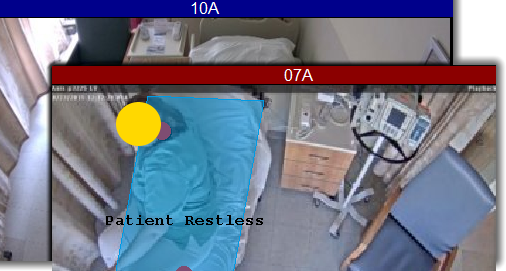
Title bar colors for status indication - color coding of each camera view title bar indicate the severity level of an individual's condition, including automatic color assignment when new patients are enrolled.
Image shows views from a low priority room (with a blue title bar) and a high priority room (with a red title bar).
Icons for special requirements - icons indicating individuals' special requirements such as "hearing impaired" can be added to the title bar of each camera view to remind caregivers the necessary steps must be followed for the intervention workflow.
Image shows the icons for "hearing impaired" and "patient not allowed in chair unattended".
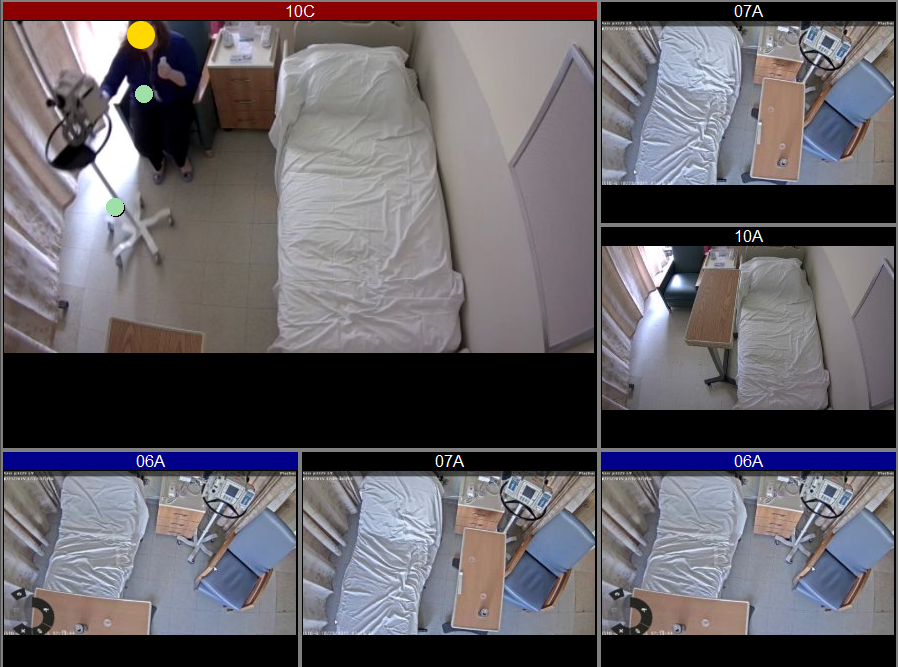
Choose priority camera to zoom - high priority rooms can be displayed larger than other video views. If staff see something of interest that requires close inspection, any camera view can be temporarily expanded with a mouse click.
Image shows a priority room view with the patient sitting in the chair, and five lower priority rooms.
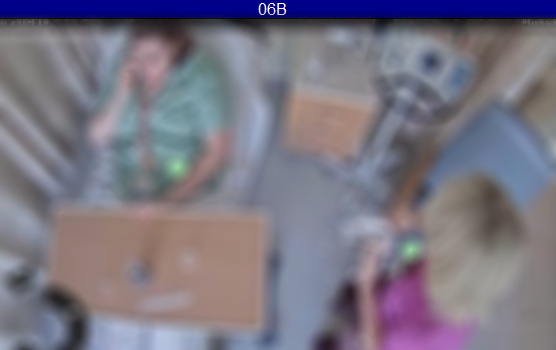
Blurred view privacy options - the video from any camera can be blurred to maintain the privacy of the individuals.
Image shows video from a room blurred during a procedure, allowing for privacy and reducing distraction. Standard video can be resumed after the procedure is complete.
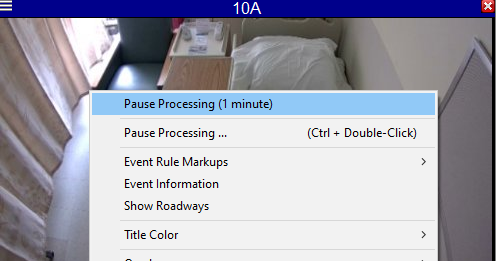
Pause processing for a time period - analytics processing for any camera can be paused for a selected duration as needed; for instance if a medical procedure is being on a patient or the elderly is being helped by a caregiver.
Image shows a view paused while staff clean the room. A customizable default duration can be selected or a custom pause duration.
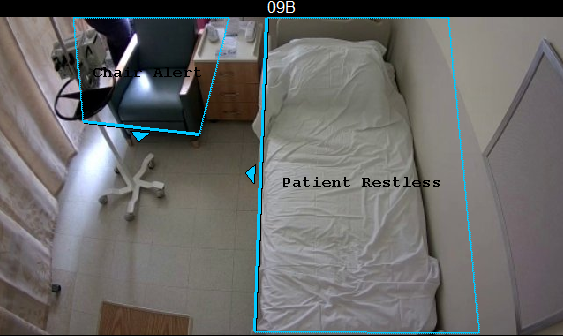
Event zones and markups - monitoring staff can adjust zones of interest directly from intuVision VA Review Application, and can see the event zones and detected object markups overlain on live video.
Image shows adjustable zones around chair and bed.
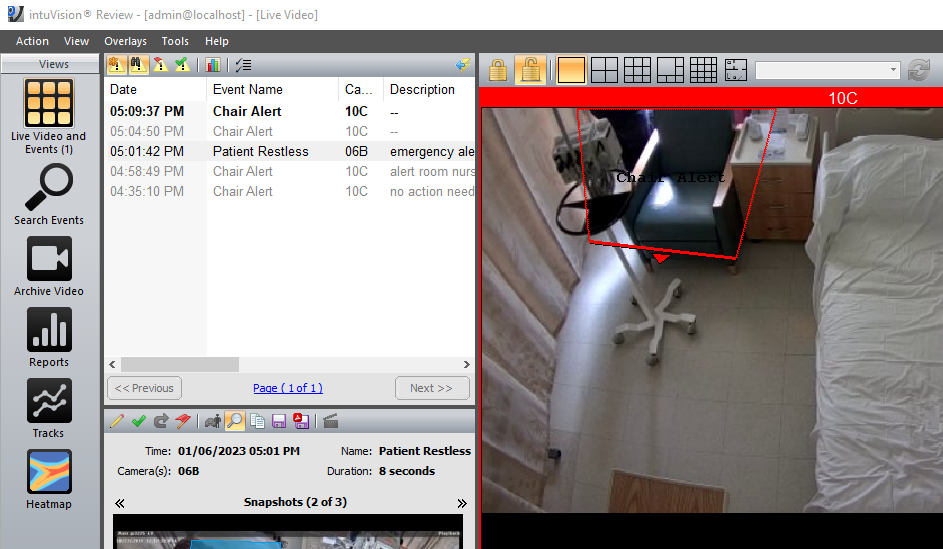
Alarm notification options - a range of alarm notification options are available - including customizable audio alerts, the display grid frame of the video flashing red, and/or the event zone flashing red upon detection of a "patient restless" or "patient leaving bed" alert.
Image shows alert indicators after the patient leaves the chair. Video border and the event zone flashes red, and the new event alert appears in bold font in the event list.
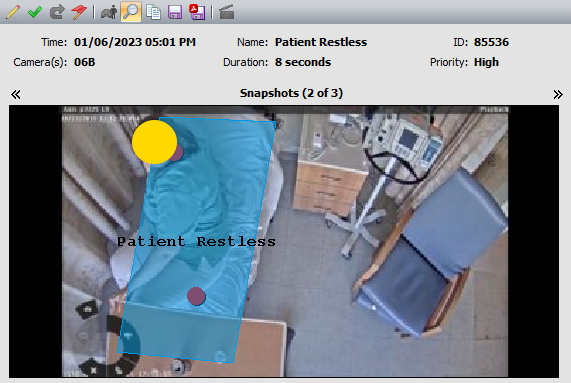
View alarm details - when intuVision VA detects a fall-risk event and alarms, a snapshot of the detected event is displayed, as well as the live video. Staff can readily verify the patient status and follow the intervention workflow procedure.
Image shows event details after a patient begins to get out of bed, including event snapshot, camera name, and other details.
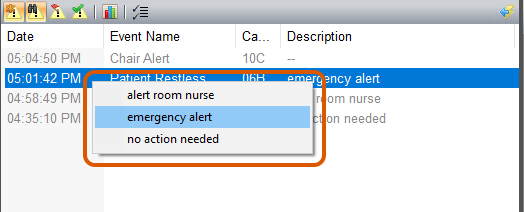
Customizable alarm acknowledgement templates - staff can right-click on an event to access their pre-defined list of alarm acknowledgements, such as "alert room nurse", "emergency alert", or "no action needed".
Image shows some recommended acknowledgement defaults, including nurse response and actions.

Nurses, nurse leaders, administrative users, etc. - each group can have different permissions, guaranteeing that system settings will only be configured and modified by sufficiently trained staff. Permissions include adjusting camera settings, defining acknowledgement templates, modifying event zones, etc.
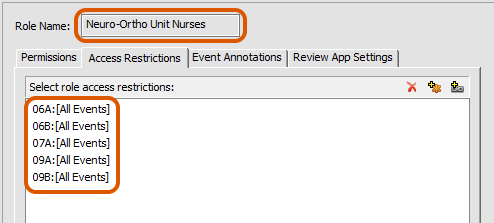
Assign users to certain floors or rooms - within broader privilege levels, staff can be assigned to only specific cameras or types of alarm detections making sure each patient/room video is managed by appropriate staff.
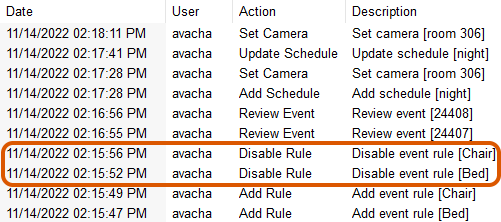
User action tracking - user actions are tracked and logged within the intuVision system and are easily searchable to assist investigation efforts after incidents and can be used in further training of staff.
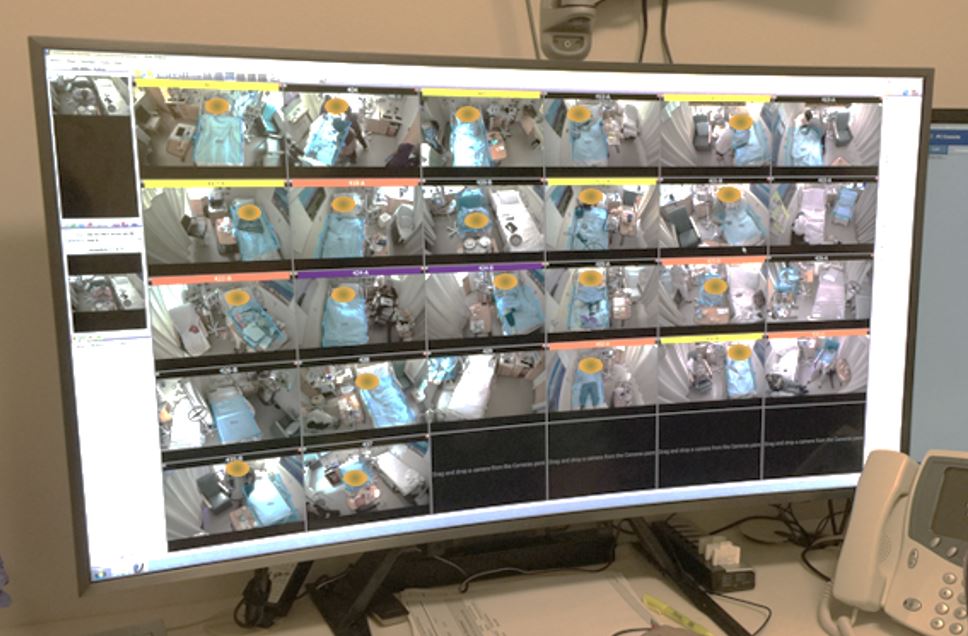
intuVision VA’s patented algorithms are the cornerstone of the Constant Care Program, to ensure safety and prevent falls of at-risk patients at Memorial Sloan Kettering Cancer Center in New York City. Deployed in 250 high fall-risk patient rooms, the analytics are used to alert as patients prepare to get out of bed or the chair, for fall prevention and early intervention.
Ceiling mounted cameras in each room allow for monitoring of the bed and chair zones, providing safety whether the patients are in bed or sitting. intuVision VA is configurable for both early alerts indicating patient movement within the bed, and alerts on the patient getting out of bed or the chair.
Working in closely with hospital staff, intuVision Review Application was customized to fall-risk monitoring use case- providing a complete system for fall prevention, live video review and early intervention, within the high paced patient monitoring environment.
Initial project included a 43 bed inpatient adult surgical unit was completed in 2016, with intuVision VA analyzing live video from cameras in patient rooms and staff workflows focusing on video detection, communication, and notifications.
Ceiling mounted cameras for each room allow complete overview of the room, minimizing occlusions due to equipment or other visitors.
Constant Care stations with large displays to monitor patient rooms.
Servers processing video from multiple floors, with rooms allocated to Constant Care staff through intuVision VA user-group assignments.